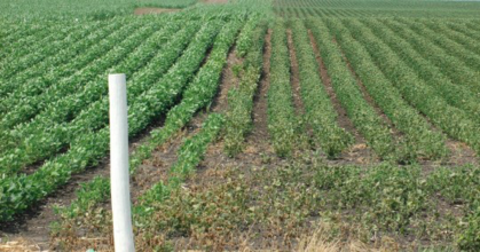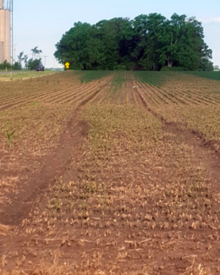Historically, dicamba has been a challenging herbicide to keep in place. Its high vapor pressure makes it one of the most volatile herbicides.
At the same time Xtend soybean was released, a dicamba-tolerant variety, new formulations and labels were developed to contain dicamba's wayward ways.
This new technology includes formulations with VaporGrip Technology (Xtendimax and FeXapan) and a new salt formulation (Engenia) designed to reduce volatility.
However, reduced volatility doesn’t mean no volatility. Recently published research found that non-Xtend beans showed dicamba exposure symptoms at 1/20,000 of the 1x rate, which is 0.5 pounds of acid equivalent (ae) formulation per acre. When you factor in even a small amount of volatility into this finding, you can understand the challenge of containing dicamba’s wayward ways.
Scale of off-target movement
Off-target dicamba movement wasn’t confined to just Minnesota during the 2017 growing season. According to the University of Missouri, there were 2,708 cases of dicamba-injured soybeans reported throughout the United States.
The area included 25 states and spanned from the Dakotas to Oklahoma to the East Coast. It’s estimated there were around 3.6 million acres of injured soybean. In Minnesota, 250 cases were reported to the Minnesota Department of Agriculture during 2017. This represents 265,000 acres of dicamba-injured soybean.
Routes of exposure
Off-target dicamba movement is possible via particle drift, tank contamination and volatilization (vapor drift). However, identifying how exposure occurred isn’t always obvious or easy.
Spray particle drift occurs during application when wind carries small droplets from the targeted field to neighboring areas.
To avoid particle drift, use larger spray droplets with low pressure and only apply dicamba when wind speeds are low. New label requirements allow applications only when wind speeds are between 3 and 10 miles per hour.
Identifying spray particle drift
Spray particle drift may be the easiest type of off-target movement to identify in the field.
Symptoms are usually most noticeable along the edge of the field next to the drift source. They lessen as the distance from the source increases (Figure 2).
Remember, the symptoms of dicamba exposure depend largely on the dose. Symptoms are different on soybean directly sprayed with dicamba compared with soybean exposed to a very low concentration farther from the source.
Soybeans directly sprayed with dicamba will frequently be dead, while soybeans exposed to low concentrations farther away will show less severe symptoms, such as leaf cupping.
Physical particle drift of dicamba was observed during 2017. However, it doesn’t appear to account for the majority of off-target exposure cases.
When sprayer cleanout isn’t thorough, tank contamination can occur. Removing dicamba and other plant growth regulator (PGR) herbicide residues can be especially challenging.
Dicamba residues that remain in or on the equipment are then applied at low concentrations with the subsequent postemergence herbicide.
To minimize contamination potential, read and follow all label instructions for sprayer cleanout.
Guidance on removing dicamba residues from your sprayer
Identifying tank contamination symptoms in the field
Tank contamination symptoms are often most pronounced around the fields’ perimeter. They also occur along the edge where the applicator began spraying the remainder of the field.
Symptoms often become less pronounced as the sprayer moves farther across the field, away from the side where the application began (Figure 3).
Vapor drift occurs when an herbicide changes from a liquid to a gas, and these vapors move out of the treated field.
This tendency to change from a liquid to a gas – or volatility – depends on several factors related to the herbicide formulation and environmental conditions.
Vapor pressure
An herbicide’s vapor pressure measures its tendency to volatilize. As the vapor pressure of an herbicide increases, the potential for volatility also increases.
Dicamba’s high vapor pressure makes it one of the most volatile herbicides. While new formulations have made definite improvements, reduced volatility and no volatility are not the same thing. All commercially available dicamba formulations have the potential to volatilize.
Application rate
Increasing the dicamba application rate (upper limit of 0.5 pounds of ae formulation per acre) increases volatility, due to higher concentrations on crop leaves. Similarly, volatility will increase when applying dicamba to taller corn or soybean, because the evaporative surface area is larger.
There are also volatility differences depending on the type of surface dicamba is applied to. In growth chamber studies, significantly more injury occurred when dicamba was applied to corn or soybean leaves (40 percent) than when it was applied to soil (26 percent).
Environmental conditions
Environmental conditions can affect dicamba volatilization.
Volatility tends to increase as soil moisture and temperature increase. Low relative humidity also increases the potential for volatilization. The greatest potential for dicamba vapor movement is under hot, dry conditions during and after application.
As soil moisture decreases, more dicamba can be adsorbed to soil colloids. This, in turn, reduces the amount of herbicide available to volatilize.
Combining the factors
As you consider the role of volatilization in the off-target movement of dicamba at and after application in 2017, keep this combination of factors in mind:
Temperature: High temperatures increase volatility.
Humidity: Low humidity increases volatility.
Air movement: Slow air movement concentrates dicamba vapor.
Rainfall: Dry conditions increase volatility.
Soybean plant height: Taller soybeans increase leaf area, providing more evaporative surface area for volatilization.
Other products: Products such as ammonium sulfate (AMS) can cause the new dicamba formulations to disassociate to the most volatile acid form before it’s even sprayed.
Identifying volatilization injury in the field
Unlike the classic injury pattern associated with particle drift, uniform symptoms across an entire field suggest off-target movement by volatilization.
Dicamba vapor can move much farther than spray drift particles, perhaps traveling as far as half a mile.
If injury symptoms decrease as you move from the source, particle drift is the likely mechanism of off-target movement. However, if symptoms are uniform in a very large area (whole field), then volatilization is the likely mechanism.
Temperature inversions
Temperature inversions occur when warm air rises into the atmosphere and cool air settles near the ground. With the light, warm air above the cool, denser air, no air-mixing occurs.
When herbicides are applied during a temperature inversion, small droplets can remain suspended in the air for long periods of time. These concentrated particles can then drift out of the target area when winds begin to move the following morning. Where and how far they move depends on wind speed and direction.
Typically, temperature inversions start at dusk and break up when air begins mixing again at sunrise.
The dicamba label doesn’t allow applications during temperature inversions. In addition, dicamba can only be applied between sunrise and sunset.
Behrens, R. & Lueschen, W.E. (1979). Dicamba volatility. Weed Science, 27, 486-493.
Boerboom, C. (2009). Dicamba and soybeans: A controversial combo. Proceedings of the 21st Annual Integrated Crop Pest Management Conference. Iowa State University.
Bradley, K. (2017). A final report on dicamba-injured soybean acres.
Hager, A. (2017). The dicamba dilemma in Illinois: Facts and speculations.
Hartzler, B. (2017). Factors influencing dicamba volatility.
Hoidal, N. (2018). Dicamba: Tips for complying with buffer and spray drift requirements.
Loux, M. & Johnson, B. (2017). Ohio soybeans: Dicamba drift injury becoming more evident.
Miller, R. & Nicolai, D. (2017). Temperature inversions: Something to consider.
Reviewed in 2021




